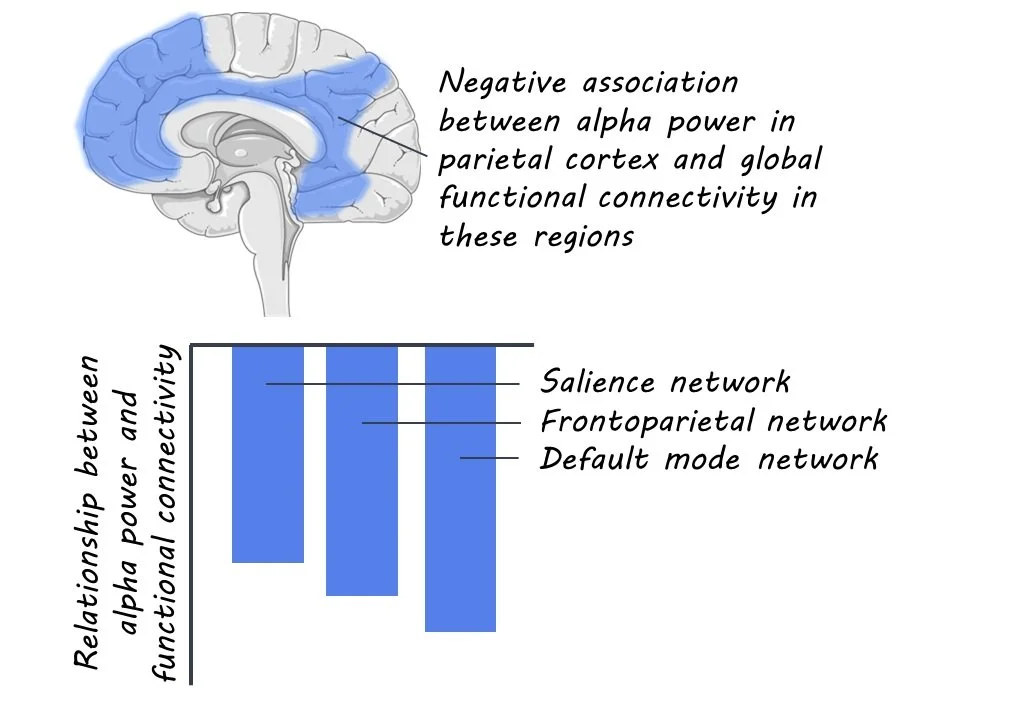Impact of DMT on Brain Function and Connectivity
Post by Lani Cupo
The takeaway
A joint fMRI and EEG experiment reveals the impact of the psychedelic DMT on brain activity, potentially lending insight into the neural correlates of consciousness.
What's the science?
N,N-Dimethyltryptamine (DMT) is a psychedelic that targets serotonin receptors and leads to an altered state of consciousness consisting of vivid imagery without a loss of consciousness. Previous functional magnetic resonance (fMRI) evidence suggests the role of recently-evolved association cortices (transmodal association cortex pole, or TOP) in the effects of DMT. However, these previous findings were obtained with fMRI, which captures not only neural activity but also vascular artifacts and other physiological noise. This week in PNAS, Timmermann and colleagues examined the acute effects of DMT on brain activity with concurrent fMRI and electroencephalograms (EEG), allowing them to correlate methodologies for increased specificity to neural activity.
How did they do it?
Twenty healthy adults participated in the study, with each participant undergoing two lab visits separated by two weeks. At the first visit, half the participants received a placebo and the other half received DMT, with each participant receiving the other treatment at the second visit. For 30 minutes, fMRI and EEG were acquired simultaneously during rest as the drug or placebo was administered. Participants also provided subjective, real-time ratings of how intense the drug experience was.
Initially, the authors examined each modality separately. With the fMRI data, they first calculated static resting state functional connectivity, or in other words they examined the degree to which activity of certain brain regions correlated with activity from other regions across the entire session. For the second fMRI analysis, they used a ‘sliding window’ approach to examine how functional connectivity changed over time throughout the scan, for example calculating correlations for the first minute, then the second minute, etc. They examined how the regional connectivity patterns related to subjective accounts of the intensity of the drug. With the EEG data, the authors looked at a) the signal over the entire period and b) the signal at different times with the sliding window approach. Finally, the authors examined the fMRI and EEG data together by incorporating EEG signals as covariates in regression models of functional connectivity (fMRI).
What did they find?
With the static functional connectivity approach (fMRI data), the authors found DMT decreased the strength of connections within brain networks as well as the segregation between networks, suggesting regions that comprise a network were less strongly correlated with each other, but more correlated with activity in other regions outside of the network. From the sliding window approach, the authors found subjective reports of greater intensity were associated with increased connectivity among networks. Regions with increased functional connectivity were associated with previously published maps of serotonin receptors, consistent with DMT’s mechanism of action in the brain.
From the EEG data alone, the authors found DMT was associated with decreases in alpha power but increases in gamma and delta power. Alpha waves decrease during sleep, and delta waves are prominent during sleep, suggesting an altered state of consciousness. One hypothesis suggests gamma waves may play a role in communication between neuronal populations, consistent with the decreased segregation of brain networks seen in the fMRI data. More intense subjective ratings were associated with increased delta power but decreased alpha power. Finally, when examining the two modalities together, the authors found that increased delta power was associated with increased functional connectivity among networks across the brain. In contrast, decreased alpha power was related to increased connectivity, including in the TOP, consistent with prior DMT studies.
What's the impact?
This study confirms previous results suggesting decreased segregation of brain networks while advancing an understanding of how psychedelics alter states of consciousness with multiple modalities. The findings imply that the high-level cortical regions that DMT affects may be necessary for human-specific cognitive traits that underlay human consciousness.

